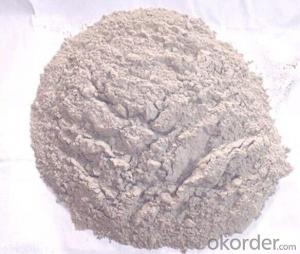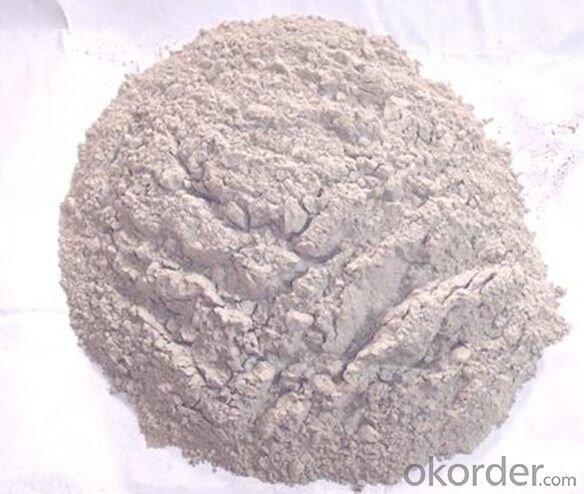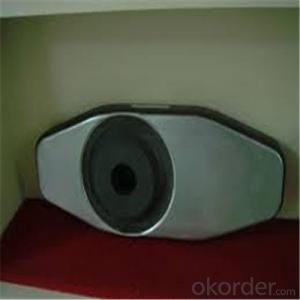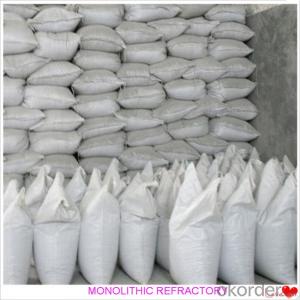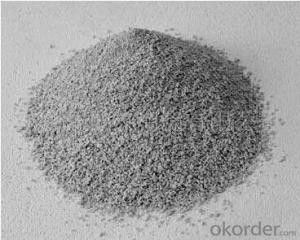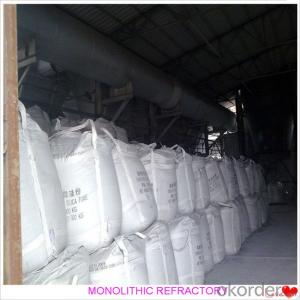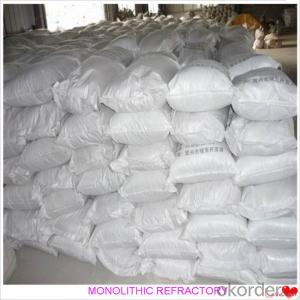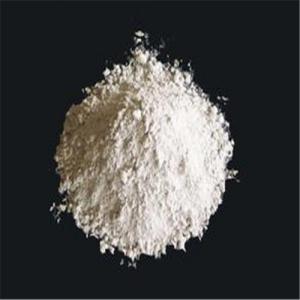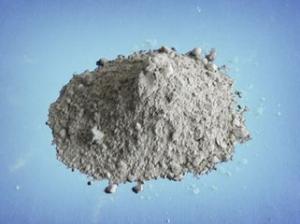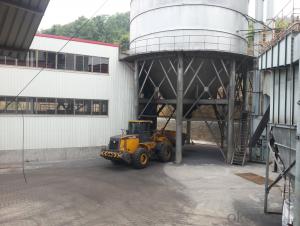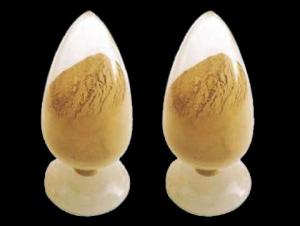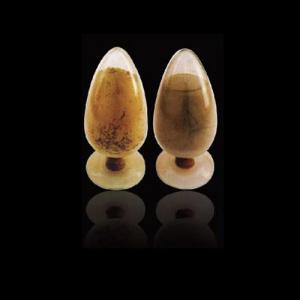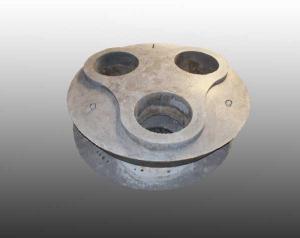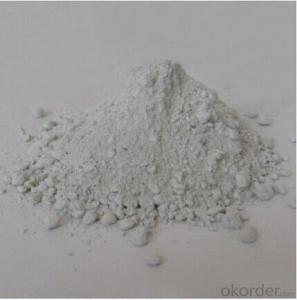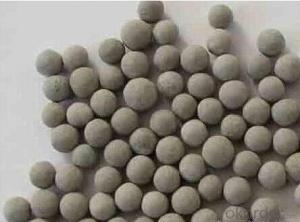Monolithic Refractories for Iron and Steel Industry:Lightweight Heat Insulating Castable
- Loading Port:
- China Main Port
- Payment Terms:
- TT OR LC
- Min Order Qty:
- -
- Supply Capability:
- -
OKorder Service Pledge
OKorder Financial Service
You Might Also Like
Specifications
insulating castable refractory
1.high strength
2.high service temperature
3.good thermal shock resistance
This Low Density Castable have the characteristics as below:
1 Low density
2 High Strength
3 Good acid resistance
4 Good alkali resistance
Low Density castable Application:
It is suitable for middle and low temperature furnace linings,ceiling and mobile cover.
Main Physical and Chemical Characteristics
Name | Light Corundum mullite castable | Light Floating Bead Ceramisite Castable | Light alkali-resisting castable | Super-light castable | ||||
NO. | CB-10 | CB-13 | QJ-120 | QJ-80 | CQ-12D | CQ-13D | CQ-450 | |
Bulk Density(110°Cdried) | 1.0 | 1.3 | 1.2 | 0.8 | 1.5 | 1.7 | 0.45 | |
Temperature of linear change is no more than 1.5% after3h in the constant Temp.(°C) | 1500 | 1450 | 1200 | 1000 | 1200 | 1300 | 950 | |
Cold Crushing strength(Mpa) | 110°C dried | 7.5 | 8 | 7.8 | 7.2 | 35 | 40 | 5.5 |
1000°C×3h | 30 | 30 | 12.5 | 12 | 30 | 35 | 6.5 | |
Heat Conductivity W/m.k | 0.35 | 0.35 | 0.31 | 0.26 | 0.26 | 0.35 | 0.26 | |
Index of thermal expansion 1000°C % | 0.55 | 0.65 | 0.75 | 0.40 | 0.40 | 0.40 | 0.20 | |
Max working temperature°C | 1450 | 1500 | 1350 | 1250 | 1300 | 1300 | 980 | |
Al2O3% | >70 | >65 | >30 | >30 | >35 | >40 | >35 | |
SiO2% | <22 | <25 | <45 | <45 | <50 | <45 | <55 | |
- Q: How do monolithic refractories perform in ladle lining applications in the iron and steel industry?
- Due to their excellent performance and durability, monolithic refractories are extensively utilized in ladle lining applications within the iron and steel industry. These refractories, which consist of a single material composition, offer numerous advantages over traditional brick linings. One significant benefit of employing monolithic refractories in ladle lining applications is their exceptional resistance to thermal shock. Ladles in the iron and steel industry experience extreme temperature fluctuations during the steelmaking process, including the pouring of molten metal and subsequent cooling. To guarantee the integrity of the ladle lining, monolithic refractories are specifically designed to endure these rapid temperature changes without cracking or spalling. In addition to their thermal shock resistance, monolithic refractories also demonstrate excellent resistance to chemical attack. The lining materials of ladles in the iron and steel industry are exposed to highly corrosive molten metal and slag, which can degrade over time. Nevertheless, monolithic refractories are formulated with high-quality raw materials that provide exceptional chemical stability, preventing the erosion and penetration of corrosive substances. Moreover, monolithic refractories offer superior mechanical strength in comparison to traditional brick linings. This is particularly crucial in ladle lining applications, as the lining must withstand the weight of the molten metal and the mechanical stresses associated with ladle handling and transportation. Monolithic refractories possess excellent load-bearing capabilities, ensuring the structural integrity of the ladle lining even under heavy loads. Another advantage of monolithic refractories is their ease of installation. Unlike brick linings, which require meticulous bricklaying, monolithic refractories can be installed using various techniques, such as gunning or casting. This allows for faster and more efficient lining repairs or replacements, reducing downtime during ladle maintenance. Consequently, iron and steel manufacturers can achieve increased productivity and cost savings. In conclusion, monolithic refractories perform exceptionally well in ladle lining applications within the iron and steel industry. Their resistance to thermal shock and chemical attack, superior mechanical strength, and ease of installation make them an ideal choice for ensuring the longevity and reliability of ladles in steelmaking operations.
- Q: How does the composition of monolithic refractories impact their performance?
- Determining the performance of monolithic refractories is heavily influenced by their composition. These refractories are unshaped materials used to line furnaces, kilns, and other high-temperature equipment. Their installation convenience and ability to conform to complex shapes make them preferable over traditional brick and mortar refractories. Various components, such as aggregates, binders, and additives, constitute the composition of monolithic refractories. These constituents significantly impact the physical, mechanical, and thermal properties of the refractory material. Aggregates, which are the primary component, provide structural integrity to monolithic refractories. Alumina, silica, magnesia, and carbon are among the materials used for aggregates. Each aggregate possesses unique properties that determine the refractory's resistance to heat, chemical attack, and mechanical stress. For instance, alumina aggregates offer excellent resistance to high temperatures and chemical corrosion, while carbon-based aggregates have high thermal conductivity and are preferred for this reason. The addition of binders enhances the strength and cohesion of the refractory. Common binders include clay, calcium aluminate cement, and colloidal silica. The choice of binder depends on the desired strength, workability, and setting time of the refractory material. Additives are incorporated into the composition to improve specific properties. They can enhance the refractory's resistance to thermal shock, abrasion, or chemical attack. Additives like zirconium oxide, silicon carbide, and graphite are frequently used to enhance the performance of monolithic refractories in specific applications. The proper combination and proportion of these constituents are vital for achieving the desired performance of monolithic refractories. The composition affects the refractory's thermal conductivity, thermal expansion, density, porosity, and chemical resistance. For example, a higher alumina content improves resistance to high temperatures and chemical corrosion, while a higher silica content enhances insulation properties. In conclusion, the performance of monolithic refractories is significantly impacted by their composition. Careful consideration must be given to the selection of aggregates, binders, and additives to achieve desired properties and ensure optimal performance in specific high-temperature applications.
- Q: What are the challenges faced in the application of monolithic refractories?
- Some challenges faced in the application of monolithic refractories include proper material selection, achieving proper installation techniques, ensuring consistent and uniform application, controlling drying and curing processes, and dealing with potential shrinkage and cracking issues. Additionally, monolithic refractories often require skilled labor for installation and maintenance, and they may be susceptible to erosion, thermal shock, and chemical attack in certain environments.
- Q: How do monolithic refractories withstand the chemical attacks in aluminum furnace applications?
- Monolithic refractories withstand chemical attacks in aluminum furnace applications due to their high resistance to oxidation and corrosion. They are specifically designed to withstand the harsh environment of aluminum processing, which involves exposure to molten aluminum, alkaline fluxes, and other corrosive chemicals. Monolithic refractories have excellent chemical stability, low porosity, and high thermal shock resistance, which allows them to maintain their structural integrity and protect the furnace lining from chemical erosion. Additionally, these refractories often contain additives such as antioxidants and anti-corrosion agents that further enhance their resistance to chemical attacks in aluminum furnace applications.
- Q: What are the specific requirements of monolithic refractories for blast furnace applications?
- Monolithic refractories used in blast furnace applications have specific requirements to withstand the harsh conditions and high temperatures within the furnace. Some of these requirements include: 1. Thermal stability: Monolithic refractories need to have excellent thermal stability to withstand the extreme temperatures encountered in blast furnaces. They should resist thermal shock and maintain their physical and chemical properties at high temperatures. 2. High strength: Blast furnace conditions exert significant pressure and mechanical stress on refractory linings. Therefore, monolithic refractories need to have high strength and resistance to mechanical wear to withstand the weight of the burden and the movement of materials inside the furnace. 3. Chemical resistance: Blast furnace environments are highly corrosive due to the presence of molten metals, slag, and gases. Monolithic refractories should exhibit excellent chemical resistance to prevent chemical reactions with the molten material and gases, which can lead to refractory degradation. 4. Erosion and abrasion resistance: The materials being processed in a blast furnace can cause erosion and abrasion, leading to wear of the refractory lining. Monolithic refractories used in blast furnaces should be able to withstand these erosive and abrasive forces to ensure a longer service life. 5. Low porosity: Blast furnace refractories should have low porosity to minimize the penetration of molten materials and gases, which can cause refractory spalling and damage. Low porosity also helps in maintaining the thermal stability and overall performance of the refractory lining. 6. Dense structure: The refractory lining in a blast furnace should have a dense structure to prevent the penetration of molten slag and metal into the lining, which can cause refractory failure. A dense structure also aids in the refractory's heat insulation properties. 7. Easy installation: Blast furnace refractories need to be easily installed and repaired due to the frequent maintenance and repair requirements of blast furnaces. Monolithic refractories offer the advantage of easy installation, as they can be cast, gunned, or sprayed onto the refractory surface, allowing for quick repairs and reduced downtime. Overall, the specific requirements of monolithic refractories for blast furnace applications include thermal stability, high strength, chemical resistance, erosion and abrasion resistance, low porosity, dense structure, and easy installation. Meeting these requirements ensures the durability and efficiency of the refractory lining, leading to improved blast furnace performance.
- Q: What are the environmental considerations associated with monolithic refractories?
- Monolithic refractories, which are used in various high-temperature applications, have several environmental considerations that need to be taken into account. Firstly, the production of monolithic refractories involves the use of raw materials such as clay, silica, and alumina, which are often mined from the earth. The extraction of these materials can result in habitat destruction, soil erosion, and water pollution. Additionally, the manufacturing process of monolithic refractories typically involves high-energy consumption and the release of greenhouse gases. The firing of refractory materials requires high temperatures, often achieved through the burning of fossil fuels, which contributes to carbon dioxide emissions and climate change. These emissions can have far-reaching environmental impacts, including air pollution, acid rain, and the depletion of the ozone layer. Furthermore, the disposal of monolithic refractories at the end of their useful life can also pose environmental challenges. While monolithic refractories are highly durable and long-lasting, there may come a point when they need to be replaced or repaired. The disposal of refractory waste can be problematic, as it often contains hazardous materials like chromium, lead, and asbestos. Improper disposal methods can lead to soil and water contamination, posing risks to human health and the environment. To address these environmental considerations, efforts are being made to develop more sustainable refractory materials and manufacturing processes. For instance, alternative raw materials like recycled refractory materials or industrial by-products can be used to reduce the environmental impact of mining. Furthermore, the adoption of more energy-efficient manufacturing techniques, such as utilizing renewable energy sources or implementing advanced firing technologies, can help to minimize greenhouse gas emissions. In conclusion, the environmental considerations associated with monolithic refractories include habitat destruction, energy consumption, greenhouse gas emissions, and waste disposal. It is crucial for the refractory industry to prioritize sustainability and adopt measures to mitigate these environmental impacts, such as using alternative raw materials, improving manufacturing processes, and promoting responsible waste management practices.
- Q: How are monolithic refractories used in the iron and steel industry?
- Monolithic refractories are extensively used in the iron and steel industry for various applications due to their superior performance and versatility. These refractories are composed of a single, uniform material and are designed to be used as a seamless lining in high-temperature environments. In the iron and steel industry, monolithic refractories play a crucial role in different stages of the manufacturing process. One of the primary applications is in the blast furnace, where monolithic refractories are used to line the inside of the furnace. This lining is subjected to extremely high temperatures and harsh chemical reactions. Monolithic refractories provide excellent thermal insulation and resistance to chemical attack, ensuring the structural integrity and longevity of the blast furnace. Another important application is in the steelmaking process. Monolithic refractories are used to line the ladles and tundish, which are used to transport and pour molten steel. These refractories are specially designed to withstand the high temperatures and corrosive nature of the molten steel, preventing contamination and ensuring the quality of the final product. Moreover, monolithic refractories are also used in various ancillary equipment and structures in the iron and steel industry. They are employed in furnaces, kilns, and other heat treatment systems to provide insulation and maintain high-temperature conditions. Additionally, monolithic refractories are used in the construction of chimneys, exhaust ducts, and other exhaust systems, where they provide thermal insulation and resistance to corrosive gases. Overall, monolithic refractories play a vital role in the iron and steel industry by providing high-temperature insulation, chemical resistance, and durability. They help optimize the production process, improve energy efficiency, and ensure the quality of the final product. With their versatility and excellent performance, monolithic refractories have become an indispensable component in the iron and steel manufacturing industry.
- Q: How do monolithic refractories improve the performance and efficiency of iron and steel production?
- Improved performance and efficiency in iron and steel production are achieved through the utilization of monolithic refractories. These specialized materials are designed to withstand extreme temperatures, chemical reactions, and mechanical stresses, making them ideal for high-temperature industrial processes. A key contribution of monolithic refractories is their ability to provide a protective lining for furnaces, kilns, and other equipment used in iron and steel production. Their superior heat resistance ensures that the underlying structure is shielded from the intense heat, preventing any detrimental effects on the equipment. This results in reduced downtime, extended service life, and ultimately, enhanced overall efficiency. Furthermore, monolithic refractories play a crucial role in improving thermal efficiency during the production process. By minimizing heat losses, these materials help maintain a stable and uniform temperature distribution, thereby enhancing the energy efficiency of the system. Precise temperature control is of utmost importance in iron and steel production to achieve the desired metallurgical properties of the final product. Additionally, monolithic refractories exhibit excellent resistance to chemical corrosion, erosion, and slag attacks. They act as a barrier between the molten metal and the refractory lining, preventing unwanted reactions and material degradation. This preserves the integrity of the furnace lining, reducing the need for frequent repairs or replacements. Consequently, it leads to increased productivity and long-term cost savings. Moreover, the ease with which monolithic refractories can be shaped, repaired, or replaced is another advantage. Unlike traditional brick refractories, which require labor-intensive and time-consuming installation, monolithic refractories offer a more flexible and efficient application. Their flexible nature allows for easy repair of damaged areas, minimizing downtime and ensuring uninterrupted production. In summary, the utilization of monolithic refractories significantly enhances the performance and efficiency of iron and steel production. These materials provide a protective lining, improve thermal efficiency, resist chemical corrosion, and offer easy installation and repair options. By optimizing the production process, monolithic refractories contribute to higher productivity, reduced downtime, and increased cost-effectiveness in the iron and steel industry.
- Q: What are the main challenges in designing the lining system with monolithic refractories?
- Achieving proper installation is one of the primary difficulties in designing the lining system using monolithic refractories. Skilled labor and precise application techniques are required for the installation, which can involve casting, gunning, or shotcreting. The performance and longevity of the lining system can be compromised if any errors or inconsistencies occur during installation. Ensuring sufficient bonding between the monolithic refractories and the existing structure presents another challenge. To prevent delamination or separation of the refractory material from the underlying surface, proper adhesion is crucial. Factors like surface preparation, temperature differences, and mechanical stress can affect the strength of the bond, necessitating careful consideration during the design phase. The compatibility of monolithic refractories with different operating conditions also poses a challenge. Refractory materials are exposed to extreme temperatures, chemical reactions, and thermal cycling, which can result in degradation and failure. Designing a lining system that can withstand these conditions requires a thorough understanding of the refractory properties and the specific requirements of the application. Furthermore, selecting the appropriate monolithic refractory material for a given lining system is a significant challenge. There are various types of monolithic refractories available, each with its own advantages and disadvantages. When choosing the most suitable material for the application, factors like temperature range, chemical composition, thermal conductivity, abrasion resistance, and thermal shock resistance must be taken into account. Lastly, maintaining the integrity of the monolithic refractory lining system throughout its lifespan is challenging. Regular inspections, repairs, and maintenance are necessary to address issues such as cracks, erosion, or spalling. Developing a comprehensive maintenance plan and ensuring access to skilled personnel for repairs are crucial aspects of designing a successful lining system with monolithic refractories.
- Q: How do monolithic refractories contribute to reducing downtime in iron and steel plants?
- Monolithic refractories play a crucial role in reducing downtime in iron and steel plants by offering several key advantages over traditional brick refractories. Firstly, monolithic refractories are highly versatile and can be easily molded and installed, allowing for quicker repairs and replacements. Unlike brick refractories that require time-consuming and labor-intensive processes, such as bricklaying and mortar application, monolithic materials can be directly applied in a castable or gunning form, significantly reducing the downtime required for repairs. Additionally, monolithic refractories provide better thermal insulation and improved resistance to thermal shocks, which are common occurrences in iron and steel plants. This enhanced thermal performance helps to maintain stable operating temperatures and prevents sudden temperature fluctuations that can lead to refractory failure and subsequent downtime. By minimizing these thermal shocks, monolithic refractories increase the overall lifespan of the refractory lining, reducing the need for frequent repairs and replacements. Furthermore, monolithic refractories offer superior chemical resistance compared to traditional brick refractories. Iron and steel plants often encounter aggressive chemical environments due to the presence of molten metal, slag, and other corrosive substances. Monolithic refractories are specifically designed to withstand these harsh conditions, preventing chemical attacks and erosion of the refractory lining. As a result, the need for unscheduled shutdowns due to refractory degradation is significantly reduced. Lastly, monolithic refractories provide better dimensional stability, minimizing the risk of cracks and spalling that can occur due to thermal cycling and mechanical stress. This increased resistance to wear and tear ensures that the refractory lining remains intact for a longer period, reducing the frequency of maintenance and enhancing the overall operational efficiency of the iron and steel plant. In summary, monolithic refractories contribute to reducing downtime in iron and steel plants by offering faster installation, improved thermal insulation, superior chemical resistance, and enhanced dimensional stability. Their versatility and performance advantages make them a reliable choice for maintaining a reliable and efficient refractory lining, ultimately reducing the frequency and duration of plant shutdowns.
Send your message to us
Monolithic Refractories for Iron and Steel Industry:Lightweight Heat Insulating Castable
- Loading Port:
- China Main Port
- Payment Terms:
- TT OR LC
- Min Order Qty:
- -
- Supply Capability:
- -
OKorder Service Pledge
OKorder Financial Service
Similar products
Hot products
Hot Searches
Related keywords
